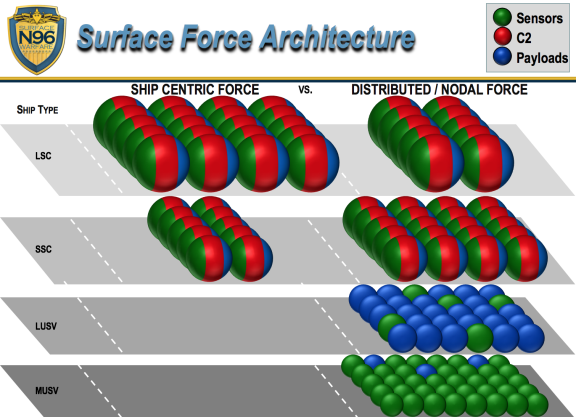Introduction
This report provides background information and potential issues for Congress for three types of large unmanned vehicles (UVs) that the Navy wants to develop and procure in FY2021 and beyond:
- Large Unmanned Surface Vehicles (LUSVs);
- Medium Unmanned Surface Vehicles (MUSVs); and
- Extra-large Unmanned Undersea Vehicles (XLUUVs).
The Navy wants to acquire these large UVs as part of an effort to shift the Navy to a new fleet architecture (i.e., a new combination of ships and other platforms) that is more widely distributed than the Navy's current fleet architecture. The Navy is requesting $579.9 million in FY2021 research and development funding for these large UVs and their enabling technologies.
The issue for Congress is whether to approve, reject, or modify the Navy's acquisition strategies and FY2021 funding requests for these large UVs. The Navy's proposals for developing and procuring them pose a number of oversight issues for Congress. Congress's decisions on these issues could substantially affect Navy capabilities and funding requirements and the shipbuilding and UV industrial bases.
In addition to the large UVs covered in this report, the Navy also wants to develop and procure smaller USVs and UUVs, as well as unmanned aerial vehicles (UAVs) of various sizes. Other U.S. military services are developing, procuring, and operating their own types of UVs. Separate CRS reports address some of these efforts.1
Background
Navy USVs and UUVs in General
UVs in the Navy
UVs are one of several new capabilities—along with directed-energy weapons, hypersonic weapons, artificial intelligence, and cyber capabilities—that the Navy says it is pursuing to meet emerging military challenges, particularly from China.2 UVs can be equipped with sensors, weapons, or other payloads, and can be operated remotely, semi-autonomously, or (with technological advancements) autonomously.3 They can be individually less expensive to procure than manned ships and aircraft because their designs do not need to incorporate spaces and support equipment for onboard human operators. UVs can be particularly suitable for long-duration missions that might tax the physical endurance of onboard human operators, or missions that pose a high risk of injury, death, or capture of onboard human operators. Consequently UVs are sometimes said to be particularly suitable for so-called "three D" missions, meaning missions that are "dull, dirty, or dangerous."4
The Navy has been developing and experimenting with various types of UVs for many years, and has transitioned some of these efforts (particularly those for UAVs) into procurement programs. The Department of the Navy states, for example, that its inventory of 4,094 aircraft at the end of FY2019 included 99 UAVs, that its projected inventory of 3,912 aircraft at the end of FY2020 will include 45 UVs, and that its projected inventory of 4,075 aircraft at the end of FY2021 will include 57 UVs.5 Even so, some observers have occasionally expressed dissatisfaction with what they view as the Navy's slow pace in transitioning UV development efforts into programs for procuring UVs in quantity and integrating them into the operational fleet.
Navy USV and UUV Categories
As shown in Figure 1 and Figure 2, the Navy organizes its USV acquisition programs into four size-based categories that the Navy calls large, medium, small, and very small, and its UUV acquisition programs similarly into four size-based categories that the Navy calls extra-large, large, medium, and small. The large UVs discussed in this CRS report fall into the top two USV categories in Figure 1 and the top UUV category in Figure 2.
The smaller UVs shown in the other categories of Figure 1 and Figure 2, which are not covered in this report, can be deployed from manned Navy ships and submarines to extend the operational reach of those ships and submarines. The large UVs covered in this CRS report, in contrast, are more likely to be deployed directly from pier to perform missions that might otherwise be assigned to manned ships and submarines.
Large UVs and Navy Ship Count
Because the large UVs covered in this report can be deployed directly from pier to perform missions that might otherwise be assigned to manned ships and submarines, some observers have a raised a question as to whether the large UVs covered in this report should be included in the top-level count of the number of ships in the Navy. Navy officials state that they have not yet decided whether to modify the top-level count of the number of ships in the Navy to include these large UVs.6
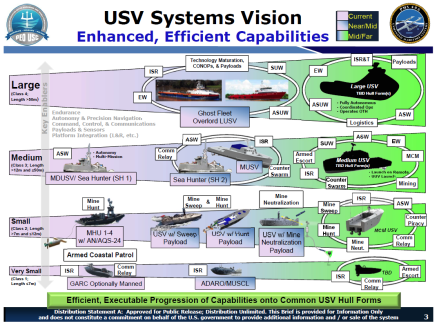 |
|
Source: Slide 3 of briefing by Captain Pete Small, Program Manager, Unmanned Maritime Systems (PMS 406), entitled "Unmanned Maritime Systems Update," January 15, 2019, accessed May 22, 2019, at https://www.navsea.navy.mil/Portals/103/Documents/Exhibits/SNA2019/UnmannedMaritimeSys-Small.pdf?ver=2019-01-15-165105-297. |
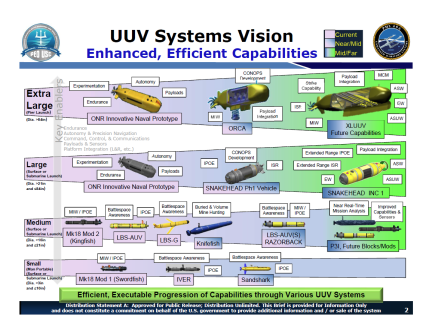 |
|
Source: Slide 2 of briefing by Captain Pete Small, Program Manager, Unmanned Maritime Systems (PMS 406), entitled "Unmanned Maritime Systems Update," January 15, 2019, accessed May 22, 2019, at https://www.navsea.navy.mil/Portals/103/Documents/Exhibits/SNA2019/UnmannedMaritimeSys-Small.pdf?ver=2019-01-15-165105-297. |
Part of More Distributed Navy Fleet Architecture
The Navy wants to acquire the large UVs covered in this report as part of an effort to shift the Navy to a new fleet architecture that is more widely distributed than the Navy's current architecture. Compared to the current fleet architecture, this more distributed architecture is to include proportionately fewer large surface combatants (or LSCs, meaning cruisers and destroyers), proportionately more small surface combatants (or SSCs, meaning frigates and Littoral Combat Ships), and the addition of significant numbers of large UVs.
Figure 3 provides, for the surface combatant portion of the Navy,7 a conceptual comparison of the current fleet architecture (shown on the left as the "ship centric force") and the new, more distributed architecture (shown on the right as the "distributed/nodal force"). The figure does not depict the entire surface combatant fleet, but rather a representative portion of it.
In the figure, each sphere represents a manned ship or USV. (Since the illustration focuses on the surface combatant force, it does not include UUVs.) As shown in the color coding, under both the current fleet architecture and the more distributed architecture, the manned ships (i.e., the LSCs and SSCs) are equipped with a combination of sensors (green), command and control (C2) equipment (red), and payloads other than sensors and C2 equipment, meaning principally weapons (blue).
Under the more distributed architecture, the manned ships would be on average smaller (because a greater share of them would be SSCs), and this would be possible because some of the surface combatant force's weapons and sensors would be shifted from the manned ships to USVs, with weapon-equipped LUSVs acting as adjunct weapon magazines and sensor-equipped MUSVs contributing to the fleet's sensor network.
As shown in Figure 3, under the Navy's current surface combatant force architecture, there are to be 20 LSCs for every 10 SSCs (i.e., a 2:1 ratio of LSCs to SSCs), with no significant contribution from LUSVs and MUSVs. This is consistent with the Navy's current force-level objective, which calls for achieving a 355-ship fleet that includes 104 LSCs and 52 SSCs (a 2:1 ratio). Under the more distributed architecture, the ratio of LSCs to SSCs would be reversed, with 10 LSCs for every 20 SSCs (a 1:2 ratio), and there would also now be 30 LUSVs and 40 MUSVs. A January 15, 2019, press report states
The Navy plans to spend this year taking the first few steps into a markedly different future, which, if it comes to pass, will upend how the fleet has fought since the Cold War. And it all starts with something that might seem counterintuitive: It's looking to get smaller.
"Today, I have a requirement for 104 large surface combatants in the force structure assessment; [and] I have [a requirement for] 52 small surface combatants," said Surface Warfare Director Rear Adm. Ronald Boxall. "That's a little upside down. Should I push out here and have more small platforms? I think the future fleet architecture study has intimated 'yes,' and our war gaming shows there is value in that."8
Another way of summarizing Figure 3 would be to say that the surface combatant force architecture (reading vertically down the figure) would change from 20+10+0+0 (i.e., a total of 30 surface combatant platforms, all manned, and a platform ratio of 2-1-0-0) for a given portion of the surface combatant force, to 10+20+30+40 (i.e., a total of 100 surface combatant platforms, 70 of which would be LUSVs and MUSVs, and a platform ration of 1-2-3-4) for a given portion of the surface combatant force. The Navy refers to the more distributed architecture's combination of LSCs, SSCs, LUSVs, and MUSVs as the Future Surface Combatant Force (FSCF).
Figure 3 is conceptual, so the platform ratios for the more distributed architecture should be understood as notional or approximate rather than exact. The point of the figure is not that relative platform numbers under the more distributed architecture would change to the exact ratios shown in the figure, but that they would evolve over time toward something broadly resembling those ratios.
Some observers have long urged the Navy to shift to a more distributed fleet architecture, on the grounds that the Navy's current architecture—which concentrates much of the fleet's capability into a relatively limited number of individually larger and more expensive surface ships—is increasingly vulnerable to attack by the improving maritime anti-access/area-denial (A2/AD) capabilities (particularly anti-ship missiles and their supporting detection and targeting systems) of potential adversaries, particularly China.9 Shifting to a more distributed architecture, these observers have argued, would
- complicate an adversary's targeting challenge by presenting the adversary with a larger number of Navy units to detect, identify, and track;
- reduce the loss in aggregate Navy capability that would result from the destruction of an individual Navy platform;
- give U.S. leaders the option of deploying USVs and UUVs in wartime to sea locations that would be tactically advantageous but too risky for manned ships; and
- increase the modularity and reconfigurability of the fleet for adapting to changing mission needs.10
For a number of years, Navy leaders acknowledged the views of those observers but continued to support the current fleet architecture. More recently, however, Navy have shifted their thinking, with comments from Navy officials like the one quoted above and Navy briefing slides like Figure 3 indicating that Navy leaders now support moving the fleet to a more distributed architecture. The views of Navy leaders appear to have shifted in favor of a more distributed architecture because they now appear to believe that such an architecture will be
- increasingly needed—as the observers have long argued—to respond effectively to the improving maritime A2/AD capabilities of other countries, particularly China;
- technically feasible as a result of advances in technologies for UVs and for networking widely distributed maritime forces that include significant numbers of UVs; and
- no more expensive, and possibly less expensive, than the current architecture.
The more distributed architecture that Navy leaders now appear to support may differ in its details from distributed architectures that the observers have been advocating, but the general idea of shifting to a more distributed architecture, and of using large UVs as a principal means of achieving that, appears to be similar. The Navy's FY2020 30-year shipbuilding plan mentions a new overarching operational concept for the Navy (i.e., a new general concept for how to employ Navy forces) called Distributed Maritime Operations (DMO).11 A December 2018 document from the Chief of Naval Operations states that the Navy will "continue to mature the Distributed Maritime Operations (DMO) concept and key supporting concepts" and "design and implement a comprehensive operational architecture to support DMO."12 While Navy officials have provided few details in public about DMO,13 the Navy does state in its FY2021 budget submission that "MUSV and LUSV are key enablers of the Navy's Distributed Maritime Operations (DMO) concept, which includes being able to forward deploy and team with individual manned combatants or augment battle groups. Fielding of MUSV and LUSV will provide the Navy increased capability and necessary capacity at lower procurement and sustainment costs, reduced risk to sailors and increased readiness by offloading missions from manned combatants."14
Accelerated Acquisition Strategies and Enabling Technologies
The Navy wants to employ accelerated acquisition strategies for procuring large UVs, so as to get them into service more quickly. The Navy's desire to employ these accelerated acquisition strategies can be viewed as an expression of the urgency that the Navy attaches to fielding large UVs for meeting future military challenges from countries such as China.15
The LUSV and MUSV programs are building on USV development work done by the Strategic Capabilities Office (SCO) within the Office of the Secretary of Defense (OSD). SCO's effort to develop USVs is called Ghost Fleet, and its LUSV development effort within Ghost Fleet is called Overlord.
As shown in Figure 4, the Navy has identified five key enabling groups of technologies for its USV and UUV programs.16 Given limitations on underwater communications (most radio-frequency electromagnetic waves do not travel far underwater), technologies for autonomous operations (such as artificial intelligence) will be particularly important for the XLUUV program (and other UUV programs).17
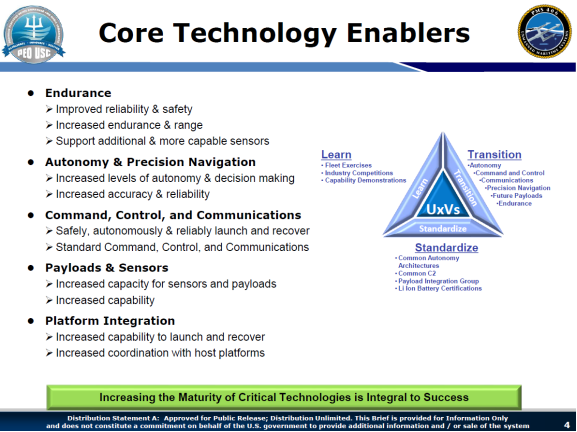 |
|
Source: Slide 4 of briefing by Captain Pete Small, Program Manager, Unmanned Maritime Systems (PMS 406), entitled "Unmanned Maritime Systems Update," January 15, 2019, accessed May 22, 2019, at https://www.navsea.navy.mil/Portals/103/Documents/Exhibits/SNA2019/UnmannedMaritimeSys-Small.pdf?ver=2019-01-15-165105-297. |
In May 2019, the Navy established a surface development squadron to help develop operational concepts for LUSVs and MUSVs. The squadron will initially consist of a Zumwalt (DDG-1000) class destroyer and one Sea Hunter prototype medium displacement USV (Figure 5). A second Sea Hunter prototype will reportedly be added around the end of FY2020, and LUSVs and MUSVs will then be added as they become available.18
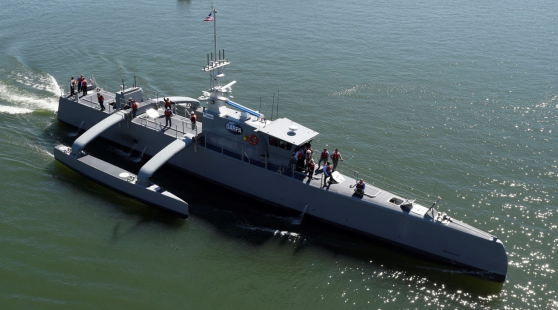 |
|
Source: Photograph credited to U.S. Navy accompanying John Grady, "Panel: Unmanned Surface Vessels Will be Significant Part of Future U.S. Fleet," USNI News, April 15, 2019. |
LUSV, MUSV, and LXUUV Programs in Brief
LUSV Program
The Navy envisions LUSVs as being 200 feet to 300 feet in length and having full load displacements of 1,000 tons to 2,000 tons, which would make them the size of a corvette. Figure 6 shows a detail from a Navy briefing slide showing images of prototype LUSVs and silhouettes of a notional LUSV and a notional MUSV. In unclassified presentations on the program, the Navy has used images of offshore support ships used by the oil and gas industry to illustrate the kinds of ships that might be used as the basis for LUSVs.19
The Navy wants LUSVs to be low-cost, high-endurance, reconfigurable ships based on commercial ship designs, with ample capacity for carrying various modular payloads—particularly anti-surface warfare (ASuW) and strike payloads, meaning principally anti-ship and land-attack missiles.20
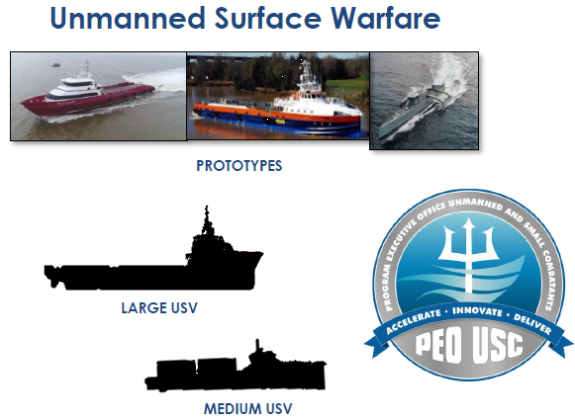 |
|
Source: Detail from Navy briefing slide entitled Unmanned Maritime Systems, slide 5 in a Navy briefing entitled "Designing & Building the Surface Fleet: Unmanned and Small Combatants," by Rear Admiral Casey Moton at a June 20, 2019, conference of the American Society of Naval Engineers (ASNE). |
The Navy wants LUSVs to be capable of operating with human operators in the loop,21 or semi-autonomously (with human operators on the loop),22 or fully autonomously, and to be capable of operating either independently or in conjunction with manned surface combatants. Although referred to as UVs, LUSVs might be more accurately described as optionally or lightly manned ships, because they might sometimes have a few onboard crew members, particularly in the nearer term as the Navy works out LUSV enabling technologies and operational concepts.23 LUSVs are to feature both built-in capabilities and an ability to accept modular payloads, and are to use existing Navy sensors and weapon launchers.
In marking up the Navy's proposed FY2020 budget, some of the congressional defense committees expressed concerns over whether the Navy's accelerated acquisition strategies provided enough time to adequately develop concepts of operations and key technologies for large UVs, particularly the LUSV. In its report (S.Rept. 116-48 of June 11, 2019) on the FY2020 National Defense Authorization Act (S. 1790), the Senate Armed Services Committee stated:
The committee is concerned that the budget request's concurrent approach to LUSV design, technology development, and integration as well as a limited understanding of the LUSV concept of employment, requirements, and reliability for envisioned missions pose excessive acquisition risk for additional LUSV procurement in fiscal year 2020. The committee is also concerned by the unclear policy implications of LUSVs, including ill-defined international unmanned surface vessel standards and the legal status of armed or potentially armed LUSVs.
Additionally, the committee notes that the Navy's "Report to Congress on the Annual Long-Range Plan for Construction of Naval Vessels for Fiscal Year 2020" acknowledges similar issues: "Unmanned and optionally-manned systems are not accounted for in the overall battle force[.] ... The physical challenges of extended operations at sea across the spectrum of competition and conflict, the concepts of operations for these platforms, and the policy challenges associated with employing deadly force from autonomous vehicles must be well understood prior to replacing accountable battle force ships."
The committee believes that further procurement of LUSVs should occur only after the lessons learned from the current SCO initiative have been incorporated into the next solicitation to enable incremental risk reduction.
In addition, the committee believes that the LUSV program, which appears likely to exceed the Major Defense Acquisition Program cost threshold, would benefit from a more rigorous requirements definition process, analysis of alternatives, and deliberate acquisition strategy.24
S.Rept. 116-48 also stated:
While recognizing the need for prototypes to reduce acquisition risk, the committee is concerned that the acquisition strategies for the Large USV, Medium USV, Orca UUV, and Snakehead UUV could lead to procurement of an excessive number of systems before the Navy is able to determine if the USVs and UUVs meet operational needs.
Therefore, the committee directs the Secretary of the Navy to submit a report to the congressional defense committees, not later than November 1, 2019, that provides acquisition roadmaps for the Large USV, Medium USV, Orca UUV, and Snakehead UUV.25
In its report (S.Rept. 116-103 of September 12, 2019) on the FY2020 DOD Appropriations Act (S. 2474), the Senate Appropriations Committee stated that
the Committee is concerned that for several unmanned programs the Navy is pursuing acquisition strategies that would limit future competitive opportunities by awarding system-level prototypes early in the acquisition process and failing to articulate capability, requirements or technology roadmaps to encourage industrial innovation. The Assistant Secretary of the Navy (Research, Development and Acquisition) is directed to submit to the congressional defense committees with the fiscal year 2021 President's budget request such acquisition roadmaps for each unmanned acquisition program that include no less than mission requirements, program requirements for each increment, key technologies, acquisition strategies, test strategies, sub-system and system-level prototyping plans, and cost estimates.26
S.Rept. 116-103 also stated
The Committee fully supports additional investments in unmanned and autonomous technologies, systems and sub-systems, including surface and sub-surface vessels. However, the Committee is concerned with the proposed acquisition and funding strategies for the MUSV and LUSV in this budget request, to include the Future Years Defense Program. Therefore, the Committee recommends several adjustments, as detailed elsewhere in this report, and directs the Assistant Secretary of the Navy (Research, Development and Acquisition) to review the acquisition strategies for these programs to address congressional concerns, as appropriately balanced with warfighter needs. (Page 194)27
The explanatory statement for the final version of the FY2020 DOD Appropriations Act (Division A of H.R. 1158/P.L. 116-93 of December 20, 2020) stated:
The Secretary of the Navy is directed to comply with the full funding policy for LUSVs in future budget submissions. Further, the agreement recommends $50,000,000 for the design of future LUSVs without a vertical launch system [VLS] capability in fiscal year 2020. Incremental upgrade capability for a vertical launch system may be addressed in future fiscal years. It is directed that no funds may be awarded for the conceptual design of future LUSVs until the Assistant Secretary of the Navy (Research, Development and Acquisition) briefs the congressional defense committees on the updated acquisition strategy for unmanned surface vessels.28
In response to the markups from the congressional defense committees, the Navy's FY2021 budget submission proposes to modify the acquisition strategy for the LUSV program so as to provide more time for developing operational concepts and key technologies before entering into serial production of deployable units. Under the Navy's proposed modified LUSV acquisition strategy, the Navy is proposing to use research and development funding to acquire two additional prototypes in FY2021 and one more additional prototype in FY2022 before shifting in FY2023 to the use of procurement funding for the procurement of deployable LUSVs at annual procurement rates in FY2023-FY2025 of 2-2-3. The Navy's FY2021 budget submission states:
Major changes [in the LUSV program] from [the] FY 2020 President's Budget request to [the] FY 2021 President's Budget request [include the following]:
(1) The program will award Conceptual Design (CD) contracts to multiple vendors in FY20. The CD effort will support refinement of a LUSV Performance Specification that does not include the Vertical Launch System (VLS). The final Performance Specification will define a LUSV with reservations in the design to support integration of a variety of capabilities and payloads. This effort, which was originally planned to award in Q2 [the second quarter of] FY 2020 will be delayed until early Q4 [the fourth quarter of] FY 2020 in order to support amendment of the CD Request for Proposals (RFP), Performance Specification, and associated artifacts.
(2) The delay in award of the LUSV CD effort will delay follow-on activities (RFP [Request for Proposals], [and] source selection) leading up to the award of the LUSV Detail Design and Construction (DD&C) contract. DD&C award will be delayed one year, from FY 2021 to FY 2022. The DD&C award will deliver a non-VLS LUSV prototype based on the Performance Specification developed during the CD effort.
(3) In lieu of the FY 2020 President's Budget request plan of awarding the LUSV DD&C contract in FY21, the Navy is planning to procure up to two additional Overlord prototypes, building on the lessons learned through the Ghost Fleet program and advances in C4I and combat system prototyping efforts.
(4) The Navy plans to transition LUSV to a program of record in FY 2023 and align [the program's] procurement funding to the Shipbuilding and Conversion, Navy (SCN) account.29
A January 13, 2020, press report stated that the Navy plans to submit a report on the Navy's concepts of operations for LUSVs and MUSVs in April 2020.30
MUSV Program
The Navy defines MUSVs as being 45 feet to 190 feet long, with displacements of roughly 500 tons. The Navy wants MUSVs, like LUSVs, to be low-cost, high-endurance, reconfigurable ships that can accommodate various payloads. Initial payloads for MUSVs are to be intelligence, surveillance and reconnaissance (ISR) payloads and electronic warfare (EW) systems. The Navy is pursuing the MUSV program as a rapid prototyping effort under what is known as Section 804 middle tier acquisition authority.31 The first MUSV prototype was funded in FY2019 and the Navy wants fund the second prototype in FY2023.
The MUSV program is building on development work by the Defense Advanced Research Projects Agency (DARPA) under its Anti-Submarine Warfare Continuous Trail Unmanned Vessel (ACTUV) effort and the Office of Naval Research (ONR) under its Medium Displacement USV effort. As shown in Figure 1, this work led to the design, construction, and testing of the prototype Sea Hunter medium displacement USV, which has a reported length of 132 feet (about 40.2 meters) and a displacement of about 140 tons.32 The Navy's MUSV program is also to employ a fleet-ready command and control (C2) solution for USVs that was developed by the Strategic Capabilities Office for the LUSV program.
XLUUV Program
The XLUUV program, also known as the Orca program, was established to address a Joint Emergent Operational Need (JEON). As shown in Figure 2, the Navy defines XLUUVs as UUVs with a diameter of more than 84 inches, meaning that XLUUVs are to be too large to be launched from a manned Navy submarine.33 Consequently, XLUUVs instead will transported to a forward operating port and then launched from pier. The Navy wants XLUUVs to be equipped with a modular payload bay for carrying mines and other payloads.
The first five XLUUVs were funded in FY2019 through the Navy's research and development appropriation account. The Navy conducted a competition for the design of the XLUUV, and announced on February 13, 2019, that it had selected Boeing to fabricate, test, and deliver the first four Orca XLUUVs and associated support elements.34 (The other bidder was a team led by Lockheed Martin.) On March 27, 2019, the Navy announced that the award to Boeing had been expanded to include the fifth Orca.35 Boeing has partnered with the Technical Solutions division of Huntington Ingalls Industries (HII) to build Orca XLUUVs.36 (A separate division of HII—Newport News Shipbuilding (NNS) of Newport News, VA—is one of the Navy's two submarine builders.)
The Navy wants procure additional XLUUVs at a rate of two per year starting in FY2023. The Navy's FY2021 budget submission does not include funding for the procurement of additional XLUUVs in FY2021 or FY2022. The Navy is proposing to fund the procurement of XLUUVs in FY2023 and subsequent years through the Other Procurement, Navy (OPN) appropriation account.
Boeing's Orca XLUUV design will be informed by (but likely differ in certain respects from) the design of Boeing's Echo Voyager UUV (Figure 7, Figure 8, and Figure 9).37 Echo Voyager is 51 feet long and has a rectangular cross section of 8.5 feet by 8.5 feet, a weight in the air of 50 tons, and a range of up to 6,500 nautical miles. It can accommodate a modular payload section up to 34 feet in length, increasing its length to as much as 85 feet. A 34-foot modular payload section provides about 2,000 cubic feet of internal payload volume; a shorter (14-foot) section provides about 900 cubic feet. Echo Voyager can also accommodate external payloads.38
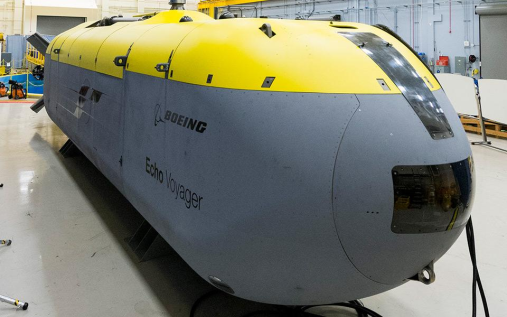 |
|
Source: Boeing photograph posted at https://www.boeing.com/defense/autonomous-systems/echo-voyager/index.page#/gallery. |
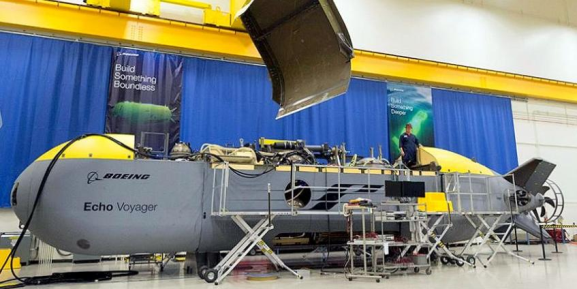 |
|
Source: Boeing photograph posted at https://www.boeing.com/defense/autonomous-systems/echo-voyager/index.page#/gallery. |
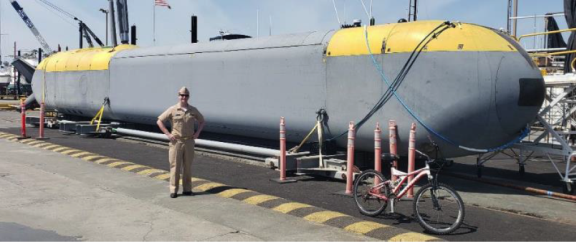 |
|
Source: Navy briefing entitled "Unmanned Maritime Systems," Howard Berkof, Deputy Program Manager, Unmanned Maritime Systems, PMS 406, Distribution A: Approved for public release; distribution unlimited, October 23, 2019, slide 5. |
FY2021-FY2025 Funding
Table 1 shows FY2021-FY2025 requested and programmed funding for the large UV programs covered in this report.
Table 1. FY2021-FY2025 Requested and Programmed Funding for Large UVs
Millions of dollars, rounded to nearest tenth
|
Program |
FY21 |
FY22 |
FY23 |
FY24 |
FY25 |
FY21-FY25 total |
|
LUSV research and development funding |
238.6 |
377.2 |
144.5 |
198.7 |
134.9 |
1,093.9 |
|
(Quantity—prototype LUSVs) |
(2) |
(1) |
(0) |
(0) |
(0) |
(3) |
|
LUSV (procurement funding |
0 |
0 |
455.0 |
373.6 |
536.6 |
1,365.2 |
|
(Quantity—deployable LUSVs) |
(0) |
(0) |
(2) |
(2) |
(3) |
(7) |
|
MUSV research and development funding |
26.3 |
30.0 |
43.0 |
43.9 |
44.7 |
187.9 |
|
(Quantity—prototype MUSVs) |
(0) |
(0) |
(1) |
(0) |
(0) |
(1) |
|
LUSV and MUSV enabling technologies research and development funding |
199.1 |
122.8 |
192.8 |
77.9 |
80.9 |
673.9 |
|
XLUUV research and development funding |
115.9 |
43.0 |
78.5 |
77.0 |
7.7 |
322.1 |
|
(Quantity) |
(0) |
(0) |
(0) |
(0) |
(0) |
(0) |
|
XLUUV procurement funding |
0 |
0 |
158.5 |
162.6 |
232.8 |
552.9 |
|
(Quantity) |
(0) |
(0) |
(2) |
(2) |
(2) |
(6) |
Source: Navy FY2021 budget submission. LUSV is Project 3066 within PE (Program Element) 0603178N (line 27 in the Navy's FY2021 research and development account). MUSV is Project 3428 within PE 0603178N (line 27). LUSV and MUSV enabling technologies is Project 3067 within PE 0603178N (line 27). XLUUV is Project 3394 within PE 0604536N (line 89).
Note: Totals may not add due to rounding.
Issues for Congress
The Navy's proposals for developing and procuring the large UVs covered in this report pose a number of oversight issues for Congress, including those discussed below.
Analytical Basis for More Distributed Fleet Architecture
One potential oversight issue for Congress concerns the analytical basis for the Navy's desire to shift to a more distributed fleet architecture featuring a significant contribution from large UVs. Potential oversight questions for Congress include the following:
- What Navy analyses led to the Navy's decision to shift toward a more distributed architecture?
- What did these analyses show regarding the relative costs, capabilities, and risks of the Navy's current architecture and the more distributed architecture?
- How well developed, and how well tested, are the operational concepts associated with the more distributed architecture?
Accelerated Acquisition Strategies and Funding Method
Another potential oversight issue for Congress concerns the accelerated acquisition strategies that the Navy wants to use for these large UV programs. Potential oversight questions for Congress include the following:
- What are the potential costs, benefits, and risks of pursuing these accelerated strategies rather than a more traditional acquisition approach that would spend more time developing the technologies and operational concepts for these UVs prior to putting them into serial production? How are those considerations affected by the shift in the international security environment from the post-Cold War era to the new era of renewed major power competition?39
- Are the Navy's proposed changes to the LUSV's accelerated acquisition strategy appropriate and sufficient?
- To what degree, if any, can these large UV programs contribute to new approaches for defense acquisition that are intended to respond to the new international security environment?
Technical, Schedule, and Cost Risk
Another potential oversight issue for Congress concerns the amount of technical, schedule, and cost risk in these programs. Potential oversight questions for Congress include the following:
- How much risk of this kind do these programs pose, particularly given the enabling technologies that need to be developed for them?
- In addition to the Navy's proposed changes to the LUSV's acquisition strategy, what is the Navy doing to mitigate or manage cost, schedule, and technical risks while it seeks to deploy these UVs on an accelerated acquisition timeline? Are these risk-mitigation and risk-management efforts appropriate and sufficient?
- At what point would technical problems, schedule delays, or cost growth in these programs require a reassessment of the Navy's plan to shift from the current fleet architecture to a more distributed architecture?
Annual Procurement Rates
Another oversight issue for Congress concerns the Navy's planned annual procurement rates for the LUSV and XLUUV programs during the period FY2021-FY2025. Potential oversight questions for Congress include, What factors did the Navy consider in arriving at them, and in light of these factors, are these rates too high, too low, or about right?
Industrial Base Implications
Another oversight issue for Congress concerns the potential industrial base implications of these large UV programs as part of a shift to a more distributed fleet architecture, particularly since UVs like these can be built and maintained by facilities other than the shipyards that currently build the Navy's major combatant ships. Potential oversight questions for Congress include the following:
- What implications would the more distributed architecture have for required numbers, annual procurement rates, and maintenance workloads for large surface combatants (i.e., cruisers and destroyers) and small surface combatants (i.e., frigates and Littoral Combat Ships)?
- What portion of these UVs might be built or maintained by facilities other than shipyards that currently build the Navy's major combatant ships?
- To what degree, if any, might the more distributed architecture and these large UV programs change the current distribution of Navy shipbuilding and maintenance work, and what implications might that have for workloads and employment levels at various production and maintenance facilities?
Potential Implications for Miscalculation or Escalation at Sea
Another oversight issue for Congress concerns the potential implications of large UVs, particularly large USVs, for the chance of miscalculation or escalation in when U.S. Navy forces are operating in waters near potential adversaries. Some observers have expressed concern about this issue. A June 28, 2019, opinion column, for example, states
The immediate danger from militarized artificial intelligence isn't hordes of killer robots, nor the exponential pace of a new arms race.
As recent events in the Strait of Hormuz indicate, the bigger risk is the fact that autonomous military craft make for temping targets—and increase the potential for miscalculation on and above the high seas.
While less provocative than planes, vehicles, or ships with human crew or troops aboard, unmanned systems are also perceived as relatively expendable. Danger arises when they lower the threshold for military action.
It is a development with serious implications in volatile regions far beyond the Gulf—not least the South China Sea, where the U.S. has recently confronted both China and Russia….
As autonomous systems proliferate in the air and on the ocean, [opposing] military commanders may feel emboldened to strike these platforms, expecting lower repercussions by avoiding the loss of human life.
Consider when Chinese naval personnel in a small boat seized an unmanned American underwater survey glider40 in the sea approximately 100 kilometers off the Philippines in December 2016. The winged, torpedo-shaped unit was within sight of its handlers aboard the U.S. Navy oceanographic vessel Bowditch, who gaped in astonishment as it was summarily hoisted aboard a Chinese warship less than a kilometer distant. The U.S. responded with a diplomatic demarche and congressional opprobrium, and the glider was returned within the week….
In coming years, the Chinese military will find increasingly plentiful opportunities to intercept American autonomous systems. The 40-meter prototype trimaran Sea Hunter, an experimental submarine-tracking vessel, recently transited between Hawaii and San Diego without human intervention. It has yet to be used operationally, but it is only a matter of time before such vessels are deployed….
China's navy may find intercepting such unmanned and unchaperoned surface vessels or mini-submarines too tantalizing to pass up, especially if Washington's meek retort to the 2016 glider incident is seen as an indication of American permissiveness or timidity.
With a captive vessel, persevering Chinese technicians could attempt to bypass anti-tamper mechanisms, and if successful, proceed to siphon off communication codes or proprietary artificial intelligence software, download navigational data or pre-programmed rules of engagement, or probe for cyber vulnerabilities that could be exploited against similar vehicles….
Nearly 100,000 ships transit the strategically vital Singapore Strait annually, where more than 75 collisions or groundings occurred last year alone. In such congested international sea lanes, declaring a foreign navy's autonomous vessel wayward or unresponsive would easily serve as convenient rationale for towing it into territorial waters for impoundment, or for boarding it straightaway….
A memorandum of understanding signed five years ago by the U.S. Department of Defense and the Chinese defense ministry, as well as the collaborative code of naval conduct created at the 2014 Western Pacific Naval Symposium, should be updated with an expanded right-of-way hierarchy and non-interference standards to clarify how manned ships and aircraft should interact with their autonomous counterparts. Without such guidance, the risk of miscalculation increases.
An incident without any immediate human presence or losses could nonetheless trigger unexpected escalation and spark the next conflict.41
Personnel Implications
Another oversight issue for Congress concerns the potential personnel implications of incorporating a significant number of large UVs into the Navy's fleet architecture. Potential questions for Congress include the following:
- What implications might these large UVs have for the required skills, training, and career paths of Navy personnel?
- Within the Navy, what will be the relationship between personnel who crew manned ships and those who operate these large UVs?
FY2021 Funding
Another oversight issue for Congress concerns the funding amounts for these programs that the Navy has requested for these programs for FY2021. Potential oversight questions for Congress include the following:
- Has the Navy accurately priced the work on these programs that it is proposing to do in FY2021?
- To what degree, if any, has funding been requested ahead of need? To what degree, if any, is the Navy insufficiently funding elements of the work to be done in FY2021?
- How might the timelines for these programs be affected by a decision to reduce (or add to) the Navy's requested amounts for these programs?
Legislative Activity for FY2021
Summary of Congressional Action on FY2021 Funding Request
Table 2 summarizes congressional action on the Navy's FY2021 funding request for the LUSV, MUSV, and XLUUV programs and their enabling technologies.
Table 2. Congressional Action on FY2021 Large UV Funding Request
Millions of dollars, rounded to the nearest tenth
|
Authorization |
Appropriation |
||||||
|
Request |
HASC |
SASC |
Conf. |
HAC |
SAC |
Conf. |
|
|
Navy research and development account |
|||||||
|
LUSV |
238.6 |
||||||
|
MUSV |
26.3 |
||||||
|
LUSV and LUSV enabling technologies |
199.1 |
||||||
|
XLUUV |
115.9 |
||||||
Sources: Table prepared by CRS based on FY2021 Navy budget submission, committee and conference reports, and explanatory statements on the FY2021 National Defense Authorization Act and the FY2021 DOD Appropriations Act.
Notes: LUSV is Project 3066 within PE (Program Element) 0603178N (line 27 in the Navy's FY2021 research and development account). MUSV is Project 3428 within PE 060317N (line 27). LUSV and MUSV enabling technologies is Project 3067 within PE 0603178N (line 27). XLUUV is Project 3394 within PE 0604536N (line 89). HASC is House Armed Services Committee; SASC is Senate Armed Services Committee; HAC is House Appropriations Committee; SAC is Senate Appropriations Committee; Conf. is conference agreement.
